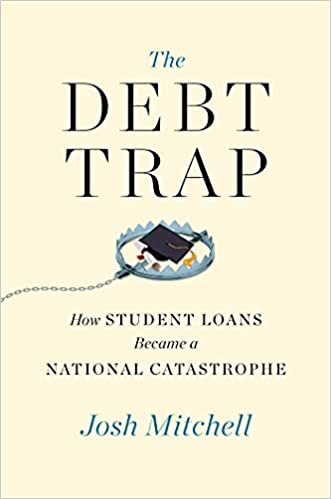You have /5 articles left.
Sign up for a free account or log in.
 The Debt Trap: How Student Loans Became a National Catastrophe by Josh Mitchell
The Debt Trap: How Student Loans Became a National Catastrophe by Josh Mitchell
Published in August 2021
More than forty-four million Americans owe over $1.7 trillion in student loans. Six in 10 undergraduate students will accumulate debt, with the average amount owed now at $29,850.
Only about a quarter of all student debt is owed by those who went to graduate school. This graduate student debt, however, accounts for half of the total amount of money owed.
The average debt for students getting a master’s degree is $71,000. Borrow for a law or medical degree, and your debt rises to $145,500 and $201,490, respectively.
Three point two million borrowers, or 37 percent of all student debt holders, owe over $100,000.
One in five student loan borrowers are in default, meaning they are not making payments but that the total size of their loans is increasing as interest charges pile up.
How did we get to this place where student loans constitute the second-largest source of personal debt, behind mortgages? (We owe about $10 trillion on our homes.)
The origins, consequences and potential solutions of the U.S. student debt story are complex. I had thought that I had a reasonably good understanding of how student debt works and why students need to borrow so much money for college. It took reading Josh Mitchell’s essential new book, The Debt Trap, to fully get my head around the magnitude of our student loan crisis.
The big gap in my knowledge that The Debt Trap filled in was about the history of student loan policies. Until reading the book, I had not realized the degree to which the federal government prioritized the profits of bankers and shareholders over the well-being of students.
Part of the student loan story is about public disinvestment in higher education. Each successive generation of students from the 1970s has been required to finance a greater share of their education at public institutions, as state support has eroded. Rising tuition costs have been funded not through tax dollars but by student debt.
Another part of the student loan crisis has to do with the growth of for-profit online education institutions that built their business models on student loans while saddling their enrollees (many of whom failed to graduate) with a lifetime of student debt.
Nonprofit colleges and universities do not escape blame for the student loan story. There is a debate about the relationship between the growth of student loans and the rapid increases of higher ed prices over the past three decades. The Debt Trap makes a strong argument for some shared culpability of nonprofit colleges and universities in our student debt crisis.
Reading The Debt Trap will make you angry at all the lost opportunities to create sensible policies that would have increased opportunities to earn a college or graduate degree without creating the conditions for unsustainable lifetime debt. Interest payments on student loans have historically gone to pad the profits and bonuses of banks and bankers (for federally guaranteed private student loans) or to pay for other government spending (for direct student loans).
Where The Debt Trap could have been expanded is less on diagnosing the disease of student debt but in offering more on solutions. The final chapter of the book contains Mitchell’s recommendations, which are sound as far as they go. The author recommends the following steps:
- Forgive interest on student loans.
- Make four-year schools put up their own money.
- Make community college truly free.
- Revise the idea of the American dream to respect and reward alternatives to the four-year degree, particularly apprenticeships.
- The government should stop subsidizing grad school.
- States, cities and communities should step up.
All these ideas make sense, but each carries with it significant challenges and consequences. I wish Mitchell had taken the space to more thoroughly examine each proposal.
For instance, many of his ideas for addressing the student loan crisis seek to shift the risk of attendance from students to schools. It is unclear where most colleges and universities will find the money to offer their own loans or how they would make up for the loss of tuition dollars if lending for graduate programs were to end.
However, forgiving interest on student loans and making community colleges truly free seems like exactly the right steps.
Completely missing from The Debt Trap is any discussion of the potential to lower the cost of higher education and therefore lower future student debt.
Readers of this blog will know that today’s most important higher education story is the evolution of low-cost (and hopefully high-quality) scaled online degrees.
The creation of affordably priced master’s programs has the potential to radically shift the conversation on credentials, quality, scale and price.
Reading The Debt Trap should provide enormous motivation for leaders of colleges and universities to prioritize investment and experimentation into developing high-quality/low-cost online degree programs.
What are you reading?








